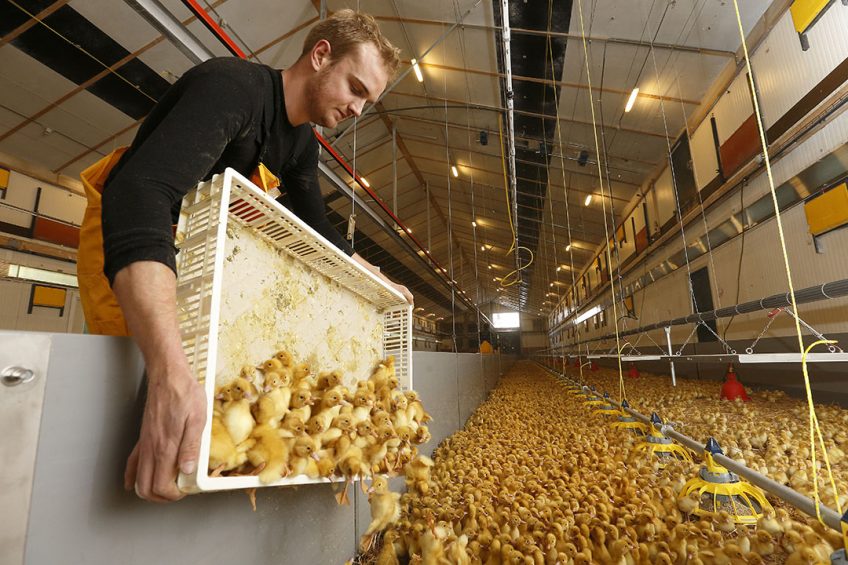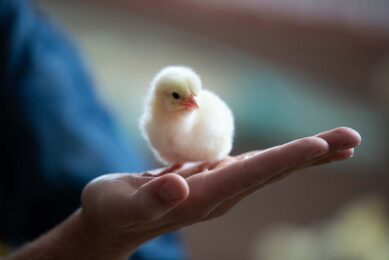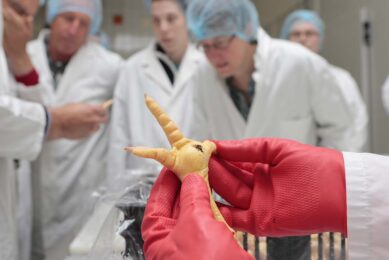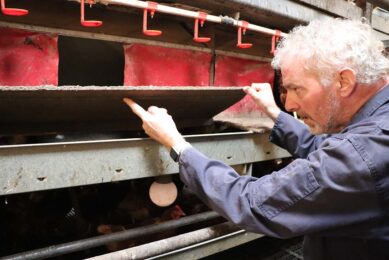Preparing for a new flock of Pekin ducks

Poultry World and Grimaud Freres describe 7 essential points to take into account when preparing for a new flock.
The first 3 days of a duck’s life determine the rest of its existence. Unlike Muscovy ducks, Pekin ducks are fast-growing, so it is necessary to ensure they can grow properly as soon as they arrive at the farm.
Pekin ducks are often seen as one of the easiest poultry species to manage. They are less sensitive to problems in early life compared to broilers, less disease prone compared to turkeys and, above all, they grow super fast. However, a good start also helps Pekin ducks to perform at par or above management recommendations. Here is what the experts advise to ensure healthy and profitable production.
 Thorough cleaning before the arrival of the Pekin ducks
Thorough cleaning before the arrival of the Pekin ducks
Cleaning is the first essential step to ensure the Pekin ducks are received into a healthy environment. Buildings and all equipment must be decontaminated to remove any microbes remaining from the previous batch.
 Disinfection in compliance with standards
Disinfection in compliance with standards
After this thorough cleaning, the disinfection stage then follows. Using viricidal, bactericidal and fungicidal products, farmers should remove all micro-organisms and undesirable viruses from their buildings. The final stage of the disinfection process is rat extermination. These first 2 stages of cleaning and disinfection will take 2 to 3 weeks.
 A completely dry building heated to 28°C
A completely dry building heated to 28°C
The disinfection downtime serves to dry out the building and establish effective sanitary barriers prior to receiving the Pekin ducks. A thick layer of good quality straw is essential for the birds’ comfort. The required temperature for newly-arrived ducklings is 28°C. They are more energetic than Muscovy ducks and move around more. They therefore need a slightly lower temperature, however, it is necessary to begin heating the building well in advance to ensure that the appropriate temperature is reached before they arrive.
 In-ovo sexing of Muscovy and Mule duck eggs
In-ovo sexing of Muscovy and Mule duck eggs
From the start of 2021 duck breeding company Grimaud Frères will introduce in-ovo sexing for Muscovy and Mule duck eggs on a commercial scale.
 Custom equipment
Custom equipment
For 50 ducklings 1 waterer and 1 feeder are recommended. A heating point, usually radiant, is also necessary for every 250 ducklings – to recreate the sensation of maternal warmth. Appropriate care of the ducklings ensures that they get off to a good, healthy start and can grow to reach their full potential.
 Good quality water
Good quality water
At this stage, it is important to flush out the water channels regularly while the ducklings are present. Farmers should check water quality by carrying out tests every year. Chlorination or other treatments will be necessary if the results are not satisfactory. Since the building is kept at a temperature of 28°C, it is also important to regularly replace the food and water.
 Almost full-time monitoring during the first few days
Almost full-time monitoring during the first few days
The first 72 hours are crucial. As soon as the ducklings arrive, the farmer should spend as much time as possible with them to observe their habits and ensure that they move around. As ossification takes place very quickly in Pekin ducks, it is important to monitor them and to supplement with the correct vitamins to strengthen their bones. Visit the ducks every 2 hours on the first day and then gradually space out visits over the following days. Experts also stress the importance of spraying ducklings with water to rehydrate them quickly in an emergency.
 An appropriate diet
An appropriate diet
Feed must be appropriate for their young age and farmers should ensure that crumbles are stirred so they remain palatable. The visual appearance of feed is crucial.
Authors: Sophie Evesque and Loïc Fruchet, Grimaud Freres
Join 31,000+ subscribers
Subscribe to our newsletter to stay updated about all the need-to-know content in the poultry sector, three times a week. Beheer
Beheer








 WP Admin
WP Admin  Bewerk bericht
Bewerk bericht